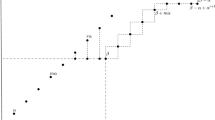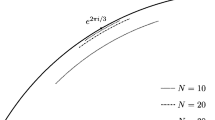Abstract
We show that the generating series of Euler characteristics of Hilbert schemes of points on any algebraic surface with at worst \(A_n\)-type singularities is described by the theta series determined by integer valued positive definite quadratic forms and the Dedekind eta function. In particular it is a Fourier development of a meromorphic modular form with possibly half integer weight. The key ingredient is to apply the flop transformation formula of Donaldson–Thomas type invariants counting two dimensional torsion sheaves on threefolds proved in the author’s previous paper.

Similar content being viewed by others
Notes
In this paper, all the varieties are defined over \(\mathbb {C}\).
The Donaldson–Thomas invariants are the weighted Euler characteristics of the moduli spaces of semistable sheaves w.r.t. the Behrend function [1]. Although they are in general different from the naive Euler numbers of the moduli spaces, they are observed to share common properties (cf. [28]). From this point, we may expect that the 3d S-duality conjecture also holds for the Euler characteristics of moduli spaces.
This last condition is required to make the computations of the Mukai vectors in Sect. 2.2 simpler, and not essential.
Since \(S^{\dag }\) is singular, we cannot simply apply the Grothendieck Riemann-Roch theorem to compute \(\mathop {\mathrm{ch}}\nolimits (i_{*}^{\dag }\mathcal {O}_{S^{\dag }}(jC^{\dag }))\). In fact, as \(\mathcal {O}_{S^{\dag }}(jC^{\dag })\) is not a perfect object, its Chern character on \(S^{\dag }\) is not defined in the usual way.
References
Behrend, K.: Donaldson-Thomas invariants via microlocal geometry. Ann. Math. 170, 1307–1338 (2009)
Behrend, K., Fantechi, B.: Symmetric obstruction theories and Hilbert schemes of points on threefolds. Algebra Number Theory 2, 313–345 (2008)
Bridgeland, T.: Flops and derived categories. Invent. Math. 147, 613–632 (2002)
Bridgeland, T.: Hall algebras and curve-counting invariants. J. Am. Math. Soc. 24, 969–998 (2011)
Bruinier, J.H., van der Geer, G., Harder, G., Zagier, D.: The 1-2-3 of Modular Forms. Letures at a Summer School in Nordfjordeid. Springer, Norway (2007)
Calabrese, J.: Donaldson–Thomas invariants on flops (to appear in Crelle). arXiv:1111.1670
Denef, F., Moore, G.: Split states, entropy enigmas, holes and halos. arXiv:hep-th/0702146
Göttsche, L.: The Betti numbers of the Hilbert scheme of points on a smooth projective surface. Math. Ann. 286, 193–207 (1990)
Göttsche, L.: Invariants of moduli spaces and modular forms. Rend. Istit. Mat. Univ. Trieste 41, 55–76 (2009)
Gholampour, A., Sheshmani, A.: Donaldson-Thomas invariants of 2-dimensional sheaves inside threefolds and modular forms (preprint). arXiv:1309.0050
Gaiotto, D., Strominger, A., Yin, X.: The M5-brane elliptic genus: modularity and BPS states. arXiv:hep-th/0607010
Gaiotto, D., Yin, X.: Examples of M5-brane elliptic genera. JHEP 0711, 004 (2007). arXiv:hep-th/0702012
Joyce, D., Song, Y.: A theory of generalized Donaldson-Thomas invariants. Mem. Am. Math. Soc. 217 (2012)
Kontsevich, M., Soibelman, Y.: Stability structures, motivic Donaldson–Thomas invariants and cluster transformations (preprint). arXiv:0811.2435
Li, J.: Zero dimensional Donaldson-Thomas invariants of threefolds. Geom. Topol. 10, 2117–2171 (2006)
Levine, M., Pandharipande, R.: Algebraic cobordism revisited. Invent. Math. 176, 63–130 (2009)
Maulik, D.: Stable pairs and the HOMFLY polynomial (preprint). arXiv:1210.6323
Maulik, D., Nekrasov, N., Okounkov, A., Pandharipande, R.: Gromov–Witten theory and Donaldson–Thomas theory. I. Compositio. Math. 142, 1263–1285 (2006)
Nishinaka, T.: Multiple D4-D2-D0 on the conifold and wall-crossing with the flop (preprint). arXiv:1010.6002
Nishinaka, T. Yamaguchi, S.: Wall-crossing of D4-D2-D0 and flop of the conifold (preprint). JHEP 1009, 026 (2010). arXiv:1007.2731
Oblomkov, A., Shende, V.: The Hilbert scheme of a plane curve singularity and the HOMFLY polynomial of its link. Duke Math. J. 161, 1277–1303 (2012)
Ooguri, H., Strominger, A., Vafa, C.: Black hole attractors and the topological string. Phys. Rev. D 70 (2004). arXiv:hep-th/0405146
Pandharipande, R., Thomas, R.P.: Stable pairs and BPS invariants. J. Am. Math. Soc. 23, 267–297 (2010)
Reid, M.: Minimal models of canonical 3-folds. In: Iitaka, S. (ed). Algebraic Varieties and Analytic Varieties, Advanced Studies in Pure Mathematics, Kinokuniya, Tokyo, North-Holland, Amsterdam, vol. 1, pp. 131–180 (1983)
Stanley, R.: Enumerative Combinatorics. Cambridge University Press, Cambridge (1999)
Thomas, R.P.: A holomorphic Casson invariant for Calabi–Yau 3-folds and bundles on \({K3}\)-fibrations. J. Differ. Geom. 54, 367–438 (2000)
Toda, Y.: Flops and S-duality conjecture (preprint). arXiv:1311.7476
Toda, Y.: Curve counting theories via stable objects I: DT/PT correspondence. J. Am. Math. Soc. 23, 1119–1157 (2010)
Toda, Y.: Curve counting theories via stable objects II. DT/ncDT flop formula. J. Reine Angew. Math. 675, 1–51 (2013)
Vafa, C., Witten, E.: A strong coupling test of S-duality. Nucl. Phys. B 431, 3–77 (1994)
Van den Bergh, M.: Three dimensional flops and noncommutative rings. Duke Math. J. 122, 423–455 (2004)
Zagier, D.: Introduction to Modular Forms, Les Houches, From Number Theory to Physics, pp. 238–291 (1992)
Acknowledgments
This work is supported by World Premier International Research Center Initiative (WPI initiative), MEXT, Japan. This work is also supported by Grant-in Aid for Scientific Research Grant (22684002) from the Ministry of Education, Culture, Sports, Science and Technology, Japan.
Author information
Authors and Affiliations
Corresponding author
Appendix: Combinatorics on Quot schemes of points on \(A_{n-1}\)
Appendix: Combinatorics on Quot schemes of points on \(A_{n-1}\)
In this appendix, we describe \(\chi (\mathop {\mathrm{Quot}}\nolimits ^{m}(\mathcal {O}_{A_{n-1}}(jD)))\) in terms of certain combinatorial data on Young diagrams. In what follows, we regard a Young diagram as a subset in \(\mathbb {Z}_{\ge 0}^{2}\) in the usual way, say:
Recall that there is a one to one correspondence between the set of ideals \(I \subset \mathbb {C}[x, y]\) generated by monomials and that of Young diagrams, by assigning \(I\) with the Young diagram \(Y_I\):
For a Young diagram \(Y\), we introduce the following notation:
Note that \(Y^{\rightarrow }\) and \(Y^{\nearrow }\) are Young diagrams with infinite number of blocks. See the following picture:
Lemma 4.1
For \(0\le j\le n-1\), the number \(\chi (\mathop {\mathrm{Quot}}\nolimits ^m(\mathcal {O}_{A_{n-1}}(-jD)))\) coincides with the number of \(n\)-tuples of Young diagrams \((Y_0, Y_1, \ldots , Y_{n-1})\) satisfying
Proof
Giving a point in \(\mathop {\mathrm{Quot}}\nolimits ^m(\mathcal {O}_{A_{n-1}}(-jD))\) is equivalent to giving an ideal \(I \subset \mathcal {O}_{A_{n-1}}\) such that \(I \subset \mathcal {O}_{A_{n-1}}(-jD)\) and \(\mathcal {O}_{A_{n-1}}(-jD)/I\) is a \(m\)-dimensional \(\mathbb {C}\)-vector space. As a \(\mathbb {C}\)-vector space, we have the decomposition
for sub vector spaces \(I_k \subset \mathbb {C}[x, y]\). Since \(I\) is an ideal in \(\mathcal {O}_{A_{n-1}}\), each \(I_k\) is an ideal in \(\mathbb {C}[x, y]\). Moreover since \(I\) must be closed under the multiplication by \(z\), we have
Since \(\mathcal {O}_{A_{n-1}}(-jD)=(x, z^j)\), the condition \(I \subset \mathcal {O}_{A_{n-1}}(-jD)\) is equivalent to \(I_k \subset (x)\) for \(0\le k \le j-1\). Hence for \(0\le k\le j-1\), we have \(I_k=I_k' \cdot (x)\) for some ideal \(I_k' \subset \mathbb {C}[x, y]\). We obtain the sequence of ideals in \(\mathbb {C}[x, y]\):
The condition that \(\mathcal {O}_{A_{n-1}}(-jD)/I\) is \(m\)-dimensional is equivalent to
Conversely suppose that we have a sequence of ideals (30) in \(\mathbb {C}[x, y]\) satisfying (31) and (29) for \(I_k=I_k' \cdot (x)\) with \(0\le k\le j-1\). Then we obtain an ideal \(I \subset \mathcal {O}_{A_{n-1}}\) by setting (28), which gives a point in \(\mathop {\mathrm{Quot}}\nolimits ^m(\mathcal {O}_{A_{n-1}}(-jD))\). Note that \(T=(\mathbb {C}^{*})^{\times 2}\) acts on \(A_{n-1}\) via \((t_1, t_2) \cdot (x, y, z)=(t_1^n x, t_2 ^n y, t_1 t_2 z)\), and the ideal (28) is \(T\)-fixed if and only if the corresponding ideals in (30) are generated by monomials. Therefore the \(T\)-fixed locus of \(\mathop {\mathrm{Quot}}\nolimits ^m(\mathcal {O}_{A_{n-1}}(-jD))\) is identified with the set of \(n\)-tuples of Young diagrams \((Y_0, \ldots , Y_n)\) satisfying (27), by assigning a sequence (30) with
as in (26). By the \(T\)-localization, we obtain the desired result. \(\square \)
Remark 4.2
The number \(\chi (\mathop {\mathrm{Quot}}\nolimits ^m(\mathcal {O}_{A_{n-1}}(-jD)))\) in Lemma 4.1 and the coefficients in the LHS of (7) are related by
as \(\mathcal {O}_{A_{n-1}}(nD) \cong \mathcal {O}_{A_{n-1}}\).
We compare the formula (7) with the numbers of \(n\)-tuples of Young diagrams in Lemma 4.1 in examples:
Example 4.3
-
(i)
If \(n=2\) and \(j=0\), then the formula (7) implies
$$\begin{aligned} \sum _{m\ge 0} \chi (\mathop {\mathrm{Hilb}}\nolimits ^m(A_1))q^m = 1+ q+3q^2 + 5q^3 + 9q^4 + 14q^5 + \cdots . \end{aligned}$$For instance, \(\chi (\mathop {\mathrm{Hilb}}\nolimits ^5(A_1))\) corresponds to the following 14 pairs of Young diagrams \((Y_0, Y_1)\):
$$\begin{aligned}&\left( \begin{array}{l} \square \! \\ \square \! \\ \square \! \\ \square \! \\ \square \! \end{array}, \emptyset \right) , \ \left( \begin{array}{l} \square \! \\ \square \! \\ \square \! \\ \square \!\square \! \end{array}, \emptyset \right) , \ \left( \begin{array}{l} \square \! \\ \square \! \\ \square \!\square \!\square \! \end{array}, \emptyset \right) , \ \left( \begin{array}{l} \square \! \\ \square \!\square \!\square \!\square \! \end{array}, \emptyset \right) , \\&\left( \begin{array}{l} \square \!\square \!\square \!\square \!\square \! \end{array}, \emptyset \right) , \ \left( \begin{array}{l} \square \! \\ \square \! \\ \square \! \\ \square \! \end{array}, \begin{array}{l} \\ \\ \\ \square \! \end{array} \right) , \ \left( \begin{array}{l} \square \! \\ \square \! \\ \square \!\square \! \end{array}, \begin{array}{l} \\ \\ \square \! \end{array} \right) , \ \left( \begin{array}{l} \square \!\square \! \\ \square \!\square \! \end{array}, \begin{array}{l} \\ \square \! \end{array} \right) , \\&\left( \begin{array}{l} \square \! \\ \square \!\square \!\square \! \end{array}, \begin{array}{l} \\ \square \! \end{array} \right) , \ \left( \begin{array}{l} \square \!\square \!\square \!\square \! \end{array}, \begin{array}{l} \square \! \end{array} \right) , \ \left( \begin{array}{l} \square \! \\ \square \! \\ \square \! \end{array}, \begin{array}{l} \\ \square \! \\ \square \! \end{array} \right) , \ \left( \begin{array}{l} \square \! \\ \square \!\square \! \end{array}, \begin{array}{l} \square \! \\ \square \! \end{array} \right) , \\&\left( \begin{array}{l} \square \! \\ \square \!\square \! \end{array}, \begin{array}{l} \\ \square \!\square \! \end{array} \right) , \ \left( \begin{array}{l} \square \!\square \!\square \! \end{array}, \begin{array}{l} \square \!\square \! \end{array} \right) . \end{aligned}$$ -
(ii)
If \(n=2\) and \(j=1\), then (7) and (32) yield
$$\begin{aligned} \sum _{m\ge 0} \chi (\mathop {\mathrm{Quot}}\nolimits ^m(\mathcal {O}_{A_1}(-D)))q^m = 1+ 2q+3q^2 + 6q^3 + 10q^4 + 16q^5 + \cdots . \end{aligned}$$Similarly to (i), \(\chi (\mathop {\mathrm{Quot}}\nolimits ^5(\mathcal {O}_{A_1}(-D)))\) corresponds to the following 16 pairs of Young diagrams \((Y_0, Y_1)\):
$$\begin{aligned}&\left( \begin{array}{l} \square \!\square \!\square \!\square \!\square \! \end{array}, \emptyset \right) , \ \left( \begin{array}{l} \square \!\square \!\square \!\square \! \end{array}, \begin{array}{l} \square \! \end{array} \right) , \ \left( \begin{array}{l} \square \! \\ \square \!\square \!\square \! \end{array}, \begin{array}{l} \\ \square \! \end{array} \right) , \ \left( \begin{array}{l} \square \!\square \!\square \! \end{array}, \begin{array}{l} \square \!\square \! \end{array} \right) , \\&\left( \begin{array}{l} \square \! \\ \square \!\square \! \end{array}, \begin{array}{l} \\ \square \!\square \! \end{array} \right) , \ \left( \begin{array}{l} \square \! \\ \square \! \\ \square \! \end{array}, \begin{array}{l} \\ \square \! \\ \square \! \end{array} \right) , \ \left( \begin{array}{l} \square \! \\ \square \!\square \! \end{array}, \begin{array}{l} \square \! \\ \square \! \end{array} \right) , \ \left( \begin{array}{l} \\ \square \!\square \!\square \! \end{array}, \begin{array}{l} \square \! \\ \square \! \end{array} \right) , \\&\left( \begin{array}{l} \\ \\ \square \!\square \! \end{array}, \begin{array}{l} \square \! \\ \square \! \\ \square \! \end{array} \right) , \ \left( \begin{array}{l} \\ \square \!\square \! \end{array}, \begin{array}{l} \square \! \\ \square \!\square \! \end{array} \right) , \ \left( \begin{array}{l} \square \!\square \! \end{array}, \begin{array}{l} \square \!\square \!\square \! \end{array} \right) , \ \left( \begin{array}{l} \\ \square \! \\ \square \! \end{array}, \begin{array}{l} \square \\ \square \! \\ \square \! \end{array} \right) , \\&\left( \begin{array}{l} \square \! \\ \square \! \end{array}, \begin{array}{l} \square \! \\ \square \!\square \! \end{array} \right) , \ \left( \begin{array}{l} \\ \\ \\ \square \! \end{array}, \begin{array}{l} \square \! \\ \square \! \\ \square \! \\ \square \! \end{array} \right) , \ \left( \begin{array}{l} \\ \\ \square \! \end{array}, \begin{array}{l} \square \! \\ \square \! \\ \square \!\square \! \end{array} \right) , \ \left( \emptyset , \begin{array}{l} \square \! \\ \square \! \\ \square \! \\ \square \! \\ \square \! \end{array} \right) . \end{aligned}$$
Rights and permissions
About this article
Cite this article
Toda, Y. S-Duality for surfaces with \(A_n\)-type singularities. Math. Ann. 363, 679–699 (2015). https://doi.org/10.1007/s00208-015-1184-1
Received:
Revised:
Published:
Issue Date:
DOI: https://doi.org/10.1007/s00208-015-1184-1




